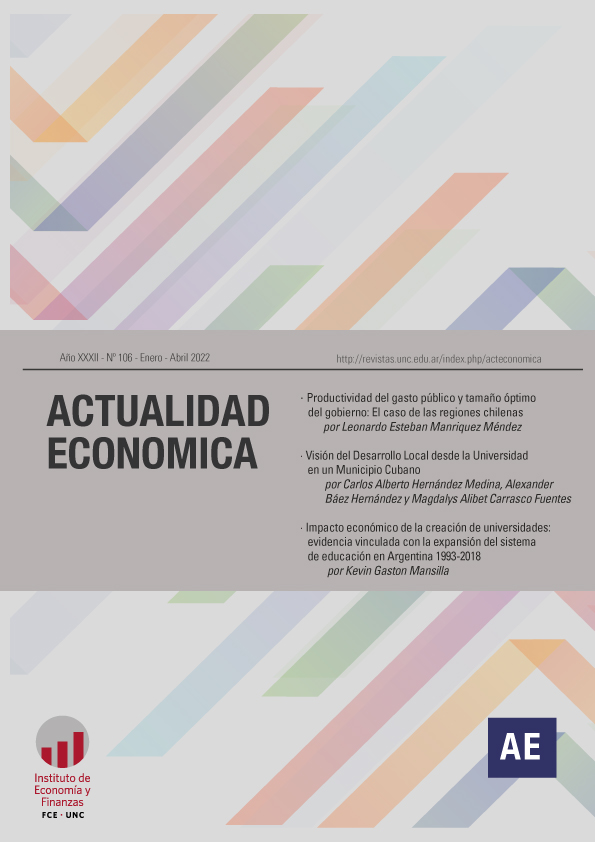The economic impact of the creation of universities: evidence linked to the expansion of the education system in Argentina 1993-2018
Keywords:
autoregressive, impact, population, universitiesAbstract
In this paper, an autoregressive spatial econometric model is used for panel data, with the aim of determining the regional economic impact on the regional geographic product (PGR) that the population level has and the creation of public management universities in Argentina, to the period 1993 – 2018. Evidence of a negative and highly significant relationship was found between the population level and the PGR per capita, on the other hand, there is a positive and significant dependence on the number of universities. Thanks to this, it can be said that the presence of universities is positively associated with economic growth.In conclusion, this work suggests that universities have a very important role in society, which goes beyond their effect as producers of human capital, that is, that we must take into account the externalities that this institution generates due to its wide impact range.
Downloads
References
Bagchi-Sen, S., & Smith, H. L. (2012). The role of the university as an agent of regional economic development. Geography Compass, 6(7), 439–453.
Barrio-Castro, T. D., & Garcı́a-Quevedo, J. (2005). Effects of university research on the geography of innovation. Regional Studies, 39(9), 1217–1229.
Bonander, C., Jakobsson, N., Podestá, F., & Svensson, M. (2016). Universities as engines for regional growth? Using the synthetic control method to analyze the effects of research universities. Regional Science and Urban Economics, 60, 198–207.
Cliff, A., & Ord, J. (1981). Spatial processes: Models and applications. Pion: London, UK.
Fingleton, B. (2000). Spatial econometrics, economic geography, dynamics and equilibrium: A “third way”? Environment and Planning A, 32(8), 1481–1498.
Fischman, G. E., & Ott, M. (2018). Access, equity and quality trends in latin america’s public universities. International Journal of Educational Development, 58, 86–94.
Goldstein, H., & Renault, C. (2004). Contributions of universities to regional economic development: A quasi-experimental approach. Regional Studies, 38(7), 733–746.
Hausman, J. A. (1978). Specification tests in econometrics. Econometrica: Journal of the Econometric Society, 1251–1271.
Hausman, N. (2012). University innovation, local economic growth, and entrepreneurship. US Census Bureau Center for Economic Studies Paper No. CES-WP-12-10.
Herrera Gómez, M. (2017). Fundamentals of applied spatial econometrics. CONICET- IELDE, National University of Salta.
Mutl, J., & Pfaffermayr, M. (2011). The hausman test in a cliff and ord panel model. The Econometrics Journal, 14(1), 48–76.
Pastor, J. M., Peraita, C., & Pérez, F. (2015). Estimating the long-term economic impacts of the spanish universities on the national economy. Louvain-La-Neuve: European Regional Science Association (ERSA).
Pastor, J. M., Peraita, C., Serrano, L., & Soler, Á. (2018). Higher education institutions, economic growth and gdp per capita in european union countries. European Planning Studies, 26(8), 1616–1637.
Quiroga Martı́nez, F. (2018). Evaluación del sistema de educación superior argentino: Análisis de la eficiencia de las universidades nacionales y de su efecto en la productividad de los individuos. Universidad Nacional de Córdoba.
Sokal, R. R., & Oden, N. L. (1978). Spatial autocorrelation in biology. Biological Journal of the Linnean Society, 10(2), 199–228.
Valero, A., & Van Reenen, J. (2019). The economic impact of universities: Evidence from across the globe. Economics of Education Review, 68, 53–67.
Downloads
Published
Issue
Section
License

This work is licensed under a Creative Commons Attribution-NonCommercial-NoDerivatives 4.0 International License.
Those authors who have published with this journal, accept the following terms:
Authors will conserve their copyright and guarantee the magazine the right of first publication of their work, which will be simultaneously subject to the Creative Commons Attribution-NonCommercial-NoDerivative 4.0 International License that allows third parties to share the work as long as the author and first publication of this magazine are indicated.
Authors may adopt other non-exclusive license agreements to distribute the published version of the work (e.g., deposit it in an institutional telematic archive or publish it in a monographic volume) provided that the initial publication in this journal is indicated.
Authors are allowed and encouraged to disseminate their work through the Internet (e.g., in institutional telematic archives or on their website) before and during the submission process, which may lead to interesting exchanges and increase citations of the published work. (See The effect of open access)









